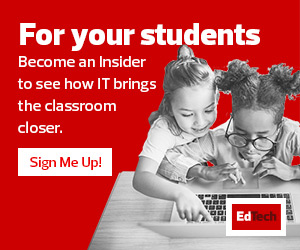A Less Tech, More Human Approach
When the district initially embarked on its blended and personalized learning venture years ago, some stakeholders were concerned that kids would spend too much time in front of screens. Others worried that school officials were attempting to replace actual teaching with computers.
Fortunately, these fears were quickly put to rest when people saw that the focus of conversations and professional development revolved around increasing time for teachers to work with students individually and in small groups.
To emphasize how vital personal interaction is to our blended learning endeavor, we adopted the motto “Less Tech, More Human.” We also looked to other tech-infused industries where computers took on administrative or routine tasks so that employees could focus on the creative and human aspects of their work.
In the medical field, for example, advances in X-rays, scans, arthroscopy, radiology and robotics have allowed breakthroughs in technology to radically improve outcomes for patients. The nurses and doctors haven’t been replaced, but the time and efficiency created by these innovations have allowed them to invest more time in patient care, consultation and well-being.
The same is true in the classroom. Today’s educational technology, for instance, enables more vigorous diagnostics, progress monitoring, adaptive curriculum and corrective feedback. This, in turn, allows teachers to more accurately personalize learning for students and spend more time coaching and mentoring.
READ MORE: These 3 online learning tools help boost remote instruction.
Supporting Students with Technology and Communication
The technological proficiencies our teachers and students built over the past several years served us well in March 2020, when stay-at-home orders took effect all over the nation. In a matter of days, our teachers and support staff transitioned smoothly to remote learning — but we had another significant challenge ahead.
Early on, we realized that not all of our students had equal access to the tools they’d need. It took a few weeks before we were able to ensure all students had devices and were connected to Wi-Fi at home. That barely scratched the surface, however, of the enormous challenges our students and their families faced. In most students’ homes, both parents work. Many students were tasked with taking care of their younger siblings and were sometimes left home alone. Some parents quit their jobs because they had no access to childcare. Knowing this, we did everything in our power to provide constant support and communication.












